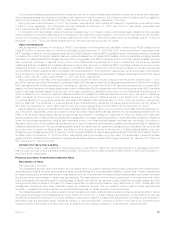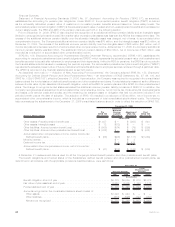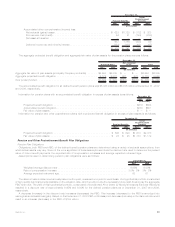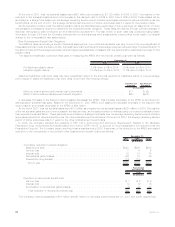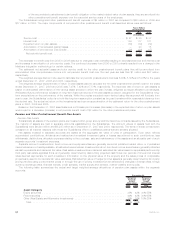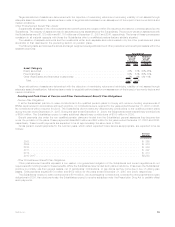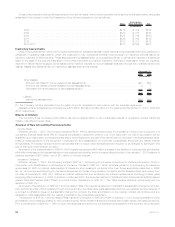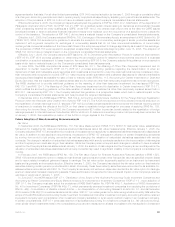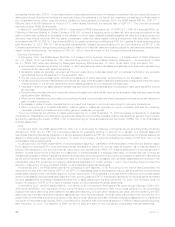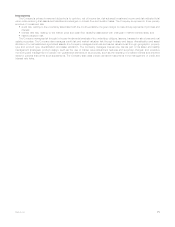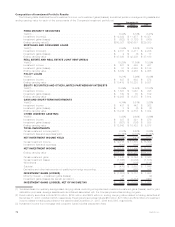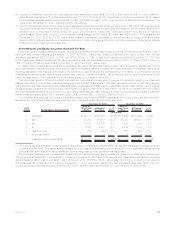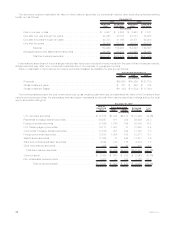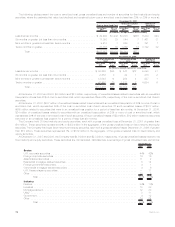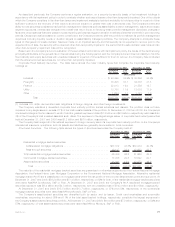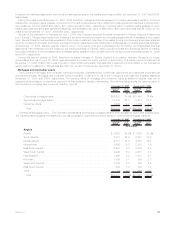MetLife 2007 Annual Report Download - page 73
Download and view the complete annual report
Please find page 73 of the 2007 MetLife annual report below. You can navigate through the pages in the report by either clicking on the pages listed below, or by using the keyword search tool below to find specific information within the annual report.agreements after that date. For all other limited partnerships, EITF 04-5 required adoption by January 1, 2006 through a cumulative effect
of a change in accounting principle recorded in opening equity or applied retrospectively by adjusting prior period financial statements. The
adoption of the provisions of EITF 04-5 did not have a material impact on the Company’s consolidated financial statements.
Effective November 9, 2005, the Company prospectively adopted the guidance in FSP No. FAS 140-2, Clarification of the Application of
Paragraphs 40(b) and 40(c) of FAS 140 (“FSP 140-2”). FSP 140-2 clarified certain criteria relating to derivatives and beneficial interests
when considering whether an entity qualifies as a QSPE. Under FSP 140-2, the criteria must only be met at the date the QSPE issues
beneficial interests or when a derivative financial instrument needs to be replaced upon the occurrence of a specified event outside the
control of the transferor. The adoption of FSP 140-2 did not have a material impact on the Company’s consolidated financial statements.
Effective July 1, 2005, the Company adopted SFAS No. 153, Exchanges of Nonmonetary Assets, an amendment of APB Opinion No. 29
(“SFAS 153”). SFAS 153 amended prior guidance to eliminate the exception for nonmonetary exchanges of similar productive assets and
replaced it with a general exception for exchanges of nonmonetary assets that do not have commercial substance. A nonmonetary
exchange has commercial substance if the future cash flows of the entity are expected to change significantly as a result of the exchange.
The provisions of SFAS 153 were required to be applied prospectively for fiscal periods beginning after June 15, 2005. The adoption of
SFAS 153 did not have a material impact on the Company’s consolidated financial statements.
Effective July 1, 2005, the Company adopted EITF Issue No. 05-6, Determining the Amortization Period for Leasehold Improvements
(“EITF 05-6”). EITF 05-6 provides guidance on determining the amortization period for leasehold improvements acquired in a business
combination or acquired subsequent to lease inception. As required by EITF 05-6, the Company adopted this guidance on a prospective
basis which had no material impact on the Company’s consolidated financial statements.
In June 2005, the FASB completed its review of EITF Issue No. 03-1, The Meaning of Other-Than-Temporary Impairment and Its
Application to Certain Investments (“EITF 03-1”). EITF 03-1 provides accounting guidance regarding the determination of when an
impairment of debt and marketable equity securities and investments accounted for under the cost method should be considered other-
than-temporary and recognized in income. EITF 03-1 also requires certain quantitative and qualitative disclosures for debt and marketable
equity securities classified as available-for-sale or held-to-maturity under SFAS No. 115, Accounting for Certain Investments in Debt and
Equity Securities, that are impaired at the balance sheet date but for which an other-than-temporary impairment has not been recognized.
The FASB decided not to provide additional guidance on the meaning of other-than-temporary impairment but has issued FSP Nos.
FAS 115-1 and FAS 124-1, The Meaning of Other-Than-Temporary Impairment and its Application to Certain Investments (“FSP 115-1”),
which nullifies the accounting guidance on the determination of whether an investment is other-than-temporarily impaired as set forth in
EITF 03-1. As required by FSP 115-1, the Company adopted this guidance on a prospective basis, which had no material impact on the
Company’s consolidated financial statements, and has provided the required disclosures.
In December 2004, the FASB issued FSP No. FAS 109-2, Accounting and Disclosure Guidance for the Foreign Earnings Repatriation
Provision within the American Jobs Creation Act of 2004 (“FSP 109-2”). The AJCA introduced a one-time dividend received deduction on
the repatriation of certain earnings to a U.S. taxpayer. FSP 109-2 provides companies additional time beyond the financial reporting period
of enactment to evaluate the effects of the AJCA on their plans to repatriate foreign earnings for purposes of applying SFAS No. 109,
Accounting for Income Taxes. During 2005, the Company recorded a $27 million income tax benefit related to the repatriation of foreign
earnings pursuant to Internal Revenue Code Section 965 for which a U.S. deferred income tax provision had previously been recorded. As
of January 1, 2006, the repatriation provision of the AJCA no longer applies to the Company.
Future Adoption of New Accounting Pronouncements
Fair Value
In September 2006, the FASB issued SFAS No. 157, Fair Value Measurements (“SFAS 157”). SFAS 157 defines fair value, establishes a
framework for measuring fair value and requires enhanced disclosures about fair value measurements. Effective January 1, 2008, the
Company adopted SFAS 157 and applied the provisions of the statement prospectively to assets and liabilities measured and disclosed at
fair value. In addition to new disclosure requirements, the adoption of SFAS 157 changes the valuation of certain freestanding derivatives
by moving from a mid to bid pricing convention as well as changing the valuation of embedded derivatives associated with annuity
contracts. The change in valuation of embedded derivatives associated with annuity contracts results from the incorporation of risk margins
and the Company’s own credit standing in their valuation. While the Company does not expect such changes in valuation to have a material
impact on the Company’s financial statements at January 1, 2008, the addition of risk margins and the Company’s own credit spread in the
valuation of embedded derivatives associated with annuity contracts may result in significant volatility in the Company’s consolidated net
income.
In February 2007, the FASB issued SFAS No. 159, The Fair Value Option for Financial Assets and Financial Liabilities (“SFAS 159”).
SFAS 159 permits entities the option to measure most financial instruments and certain other items at fair value at specified election dates
and to report related unrealized gains and losses in earnings. The fair value option is generally applied on an instrument-by-instrument
basis and is generally an irrevocable election. Effective January 1, 2008, the Company has elected the fair value option on fixed maturity
securities backing certain pension products sold in Brazil. Previously, these fixed maturity securities were accounted for as available-for-
sale securities in accordance with FAS 115. The Company’s insurance joint venture in Japan also elected the fair value option for its single
premium deferred annuities and supporting assets. These elections are not expected to have a material impact on the Company’s retained
earnings or equity as of January 1, 2008.
In June 2007, the AICPA issued SOP 07-1, Clarification of the Scope of the Audit and Accounting Guide Investment Companies and
Accounting by Parent Companies and Equity Method Investors for Investments in Investment Companies (“SOP 07-1”) . Upon adoption of
SOP 07-1, the Company must also adopt the provisions of FASB Staff Position No. FSP FIN 46(r)-7, Application of FASB Interpretation
No. 46 to Investment Companies (“FSP FIN 46(r)-7”), which permanently exempts investment companies from applying the provisions of
FIN No. 46(r), Consolidation of Variable Interest Entities — An Interpretation of Accounting Research Bulletin No. 51, and its December
2003 revision (“FIN 46(r)”) to investments carried at fair value. SOP 07-1 provides guidance for determining whether an entity falls within the
scope of the AICPA Audit and Accounting Guide Investment Companies and whether investment company accounting should be retained
by a parent company upon consolidation of an investment company subsidiary or by an equity method investor in an investment company.
In certain circumstances, SOP 07-1 precludes retention of specialized accounting for investment companies (i.e., fair value accounting),
when similar direct investments exist in the consolidated group and are measured on a basis inconsistent with that applied to investment
69MetLife, Inc.


